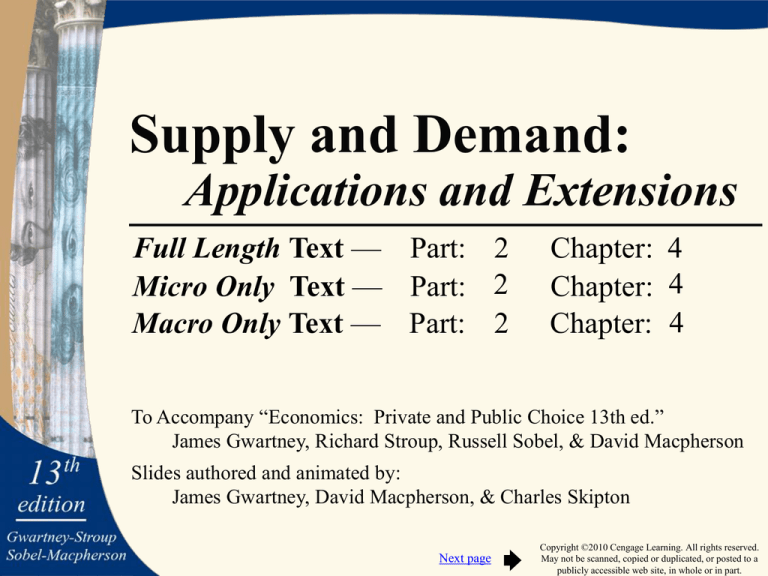
Supply and Demand:
Applications and Extensions
Full Length Text — Part: 2
Micro Only Text — Part: 2
Macro Only Text — Part: 2
Chapter: 4
Chapter: 4
Chapter: 4
To Accompany “Economics: Private and Public Choice 13th ed.”
James Gwartney, Richard Stroup, Russell Sobel, & David Macpherson
Slides authored and animated by:
James Gwartney, David Macpherson, & Charles Skipton
Next page
Copyright ©2010 Cengage Learning. All rights reserved.
May not be scanned, copied or duplicated, or posted to a
publicly accessible web site, in whole or in part.
The Linkage Between
Resource & Product Markets
Jump to first page
Copyright ©2010 Cengage Learning. All rights reserved.
May not be scanned, copied or duplicated, or posted to a
publicly accessible web site, in whole or in part.
Linkage Between
Resource and Product Markets
• The markets for resources and products are
closely linked.
• In the resource market, businesses demand
resources, while households supply them.
• Firms demand resources in order to
produce goods and services.
• Households supply them to earn income.
• The labor market is an important
resource market.
Jump to first page
Copyright ©2010 Cengage Learning. All rights reserved.
May not be scanned, copied or duplicated, or posted to a
publicly accessible web site, in whole or in part.
Linkage Between
Resource and Product Markets
• An increase in the demand for a product
will lead to an increase in the demand for the
resources used to produce it.
• In contrast, a reduction in the demand for a
product will lead to a reduction in the demand
for the resources to used produce it.
• An increase in the price of a resource will
increase the cost of producing products that
use it, shifting their supply curve to the left.
• A reduction in resource prices will have just
the opposite affect.
Jump to first page
Copyright ©2010 Cengage Learning. All rights reserved.
May not be scanned, copied or duplicated, or posted to a
publicly accessible web site, in whole or in part.
Resource Prices and Product Markets
• Suppose there is a reduction in the supply of young workers
which pushes the wages of restaurant waiters / waitress up.
• The higher wages increase the restaurant’s cost, causing a
reduction in supply in the product market … leading to
higher meal prices.
S2
Price
(wage)
Resources
Market
Price
S2
S1
Product
Market
S1
$12
$10
$11
$8
DR
E2 E1
DP
Employment
(waitstaff)
Q 2 Q1
Jump to first page
Quantity
of meals
Copyright ©2010 Cengage Learning. All rights reserved.
May not be scanned, copied or duplicated, or posted to a
publicly accessible web site, in whole or in part.
The Economics
of Price Controls
Jump to first page
Copyright ©2010 Cengage Learning. All rights reserved.
May not be scanned, copied or duplicated, or posted to a
publicly accessible web site, in whole or in part.
Price Ceilings
• A price ceiling establishes a maximum price
that sellers are legally permitted to charge.
• Example: rent control
• When a price ceiling keeps the price of a
good below the market equilibrium, there
will be both direct and indirect effects.
• (Direct effect) A shortage: the quantity
demanded will exceed the quantity supplied.
Waiting lines may develop.
• (Indirect effects) Quality deterioration and
changes in other non-price factors that are
favorable to sellers & unfavorable to buyers.
• The quantity exchanged will fall and the
gains from trade will be less than if the good
were allocated by markets.
Jump to first page
Copyright ©2010 Cengage Learning. All rights reserved.
May not be scanned, copied or duplicated, or posted to a
publicly accessible web site, in whole or in part.
The Impact of a Price Control
Price
(rent)
S
• Consider the rental housing market
where the price (rent) P0 would
bring the quantity of rental units
demanded into balance with the
quantity supplied.
• A price ceiling like P1 imposes a
price below market equilibrium …
causing quantity demanded QD …
to exceed quantity supplied QS …
resulting in a shortage.
• Because prices are not allowed to
direct the market to equilibrium,
non-price elements will become
more important in determining
where the scarce goods go.
Rental housing
market
P0
Price
ceiling
P1
Shortage
D
QS
Jump to first page
QD
Quantity of
housing units
Copyright ©2010 Cengage Learning. All rights reserved.
May not be scanned, copied or duplicated, or posted to a
publicly accessible web site, in whole or in part.
Effects of Rent Control
•
•
•
•
Shortages and black markets will develop.
The future supply of housing will decline.
The quality of housing will deteriorate.
Non-price methods of rationing will
increase in importance.
• Inefficient use of housing will result.
• Long-term renters will benefit at the
expense of newcomers.
Jump to first page
Copyright ©2010 Cengage Learning. All rights reserved.
May not be scanned, copied or duplicated, or posted to a
publicly accessible web site, in whole or in part.
Price Floor
• A price floor establishes a minimum legal
price for the good or service.
• Example: minimum wage
• When a price floor keeps the price of a
good above the market equilibrium, it will
lead to both direct and indirect effects.
• (Direct effect) A surplus: sellers will want
to supply a larger quantity than buyers are
willing to purchase.
• (Indirect effects) Changes in non-price
factors that are favorable to buyers and
unfavorable to sellers.
• The quantity exchanged will fall and the
gains from trade will be less than if the
good were allocated by markets.
Jump to first page
Copyright ©2010 Cengage Learning. All rights reserved.
May not be scanned, copied or duplicated, or posted to a
publicly accessible web site, in whole or in part.
The Impact of a Price Floor
Price
• A price floor like P1 imposes a
price above market equilibrium …
P1
causing quantity supplied Qs …
to exceed quantity demanded QD …
resulting in a surplus.
• Because prices are not allowed to
P0
direct the market to equilibrium,
non-price elements of exchange
will become more important in
determining where scarce goods go.
S
Surplus
Price
floor
D
QD
Jump to first page
QS
Quantity
Copyright ©2010 Cengage Learning. All rights reserved.
May not be scanned, copied or duplicated, or posted to a
publicly accessible web site, in whole or in part.
Minimum Wage:
An Example of a Price Floor
• When the minimum wage is set above the
market equilibrium for low-skill labor, the
following will occur:
• Direct effect:
• Reduces employment of low-skilled labor.
• Indirect effects:
• Reduction in non-wage component
of compensation
• Less on-the-job training
• May encourage students to drop out
of school
Jump to first page
Copyright ©2010 Cengage Learning. All rights reserved.
May not be scanned, copied or duplicated, or posted to a
publicly accessible web site, in whole or in part.
Employment and the Minimum Wage
Price
(wage)
• Consider the market for low-skill
labor where a price (wage) of
$5.00 could bring the quantity of
labor demanded into balance with
the quantity supplied.
• A minimum wage (price floor) of
$7.25 would increase the wages of
low-skill labor, but employment
will decline from E0 to E1 .
• Those who lose their jobs will be
pushed into either unemployment
or less preferred employment.
Excess
supply
S
Low-skill
labor market
Minimum
wage level
$ 7.25
$ 5.00
D
E1
Jump to first page
E0
Quantity
(employment)
Copyright ©2010 Cengage Learning. All rights reserved.
May not be scanned, copied or duplicated, or posted to a
publicly accessible web site, in whole or in part.
Does the Minimum Wage
Help the Poor?
• While increasing the minimum wage will
increase the wages of low-skill workers,
their on-the-job training opportunities,
non-wage benefits, working conditions,
and employment will decline.
• Who earns minimum wage?
• Most minimum wage workers are young
and / or only working part-time.
• Fewer than 20 percent are from families
with incomes below the poverty line.
Jump to first page
Copyright ©2010 Cengage Learning. All rights reserved.
May not be scanned, copied or duplicated, or posted to a
publicly accessible web site, in whole or in part.
Questions for Thought:
1. Which of the following can be expected to
result from a price ceiling that keeps the price
of a product below the market equilibrium?
a. A surplus of the product will result.
b. A shortage of the product will result.
c. Changes in non-price factors that will
be favorable to buyers and unfavorable
to sellers will occur.
d. Changes in non-price factors that will
be favorable to sellers and unfavorable
to buyers will occur.
Jump to first page
Copyright ©2010 Cengage Learning. All rights reserved.
May not be scanned, copied or duplicated, or posted to a
publicly accessible web site, in whole or in part.
Questions for Thought:
2. How would an increase in the minimum wage
from the current level to $10 per hour affect:
a. Employment in skill categories previously
earning less than $10 per hour
b. The unemployment rate of teenagers
c. The availability of on-the-job training for
low-skill workers
d. The demand for high-skill workers who provide
good substitutes for the labor offered by lowskill workers who are paid higher wage rates
due to the increase in the minimum wage.
Jump to first page
Copyright ©2010 Cengage Learning. All rights reserved.
May not be scanned, copied or duplicated, or posted to a
publicly accessible web site, in whole or in part.
Black Markets and
the Importance of
the Legal Structure
Jump to first page
Copyright ©2010 Cengage Learning. All rights reserved.
May not be scanned, copied or duplicated, or posted to a
publicly accessible web site, in whole or in part.
Black Markets
• Black market:
A market that operates outside the legal system.
• The primary sources of black markets are:
• Evasion of a price control
• Evasion of a tax
(e.g. high excise taxes on cigarettes)
• Legal prohibition on the production and
exchange of a good
(e. g., prostitution, marijuana and cocaine)
• Black markets have a higher incidence of
of defective products, higher profit rates,
and greater use of violence to resolve
disputes.
Jump to first page
Copyright ©2010 Cengage Learning. All rights reserved.
May not be scanned, copied or duplicated, or posted to a
publicly accessible web site, in whole or in part.
Importance of the Legal System
• A legal system that provides secure property
rights and unbiased enforcement of contracts
enhances the operation of markets.
• Markets will exist in any environment, but
they can be counted on to function efficiently
only when property rights are secure and
contracts enforced in an evenhanded manner.
• The inefficient operation of markets in
countries like Russia following the collapse
of communism illustrates the importance of
an even-handed legal system.
Jump to first page
Copyright ©2010 Cengage Learning. All rights reserved.
May not be scanned, copied or duplicated, or posted to a
publicly accessible web site, in whole or in part.
Questions for Thought:
1. How will the operation of black markets differ
from the operation of markets where property
rights are clearly defined and contracts are
legally enforceable?
Jump to first page
Copyright ©2010 Cengage Learning. All rights reserved.
May not be scanned, copied or duplicated, or posted to a
publicly accessible web site, in whole or in part.
The Impact of a Tax
Jump to first page
Copyright ©2010 Cengage Learning. All rights reserved.
May not be scanned, copied or duplicated, or posted to a
publicly accessible web site, in whole or in part.
Tax Incidence
• The legal assignment of who pays a tax is
called the statutory incidence.
• The actual burden of a tax (actual incidence)
may differ substantially.
• The actual burden does not depend on who
legally pays the tax (statutory incidence).
Jump to first page
Copyright ©2010 Cengage Learning. All rights reserved.
May not be scanned, copied or duplicated, or posted to a
publicly accessible web site, in whole or in part.
Impact of a Tax Imposed on Sellers
Price
• Consider the used car market
where a price of $7,000 would
bring the quantity of used cars
demanded into balance with the
quantity supplied.
• When a $1,000 tax is imposed on
the sellers of used cars, the supply $7,400
curve shifts vertically upward by
the amount of the tax.
$7,000
• The new price for used cars is
$7,400 … sellers netting $6,400 $6,400
($7,400 - $1000 tax).
• Consumers end up paying $7,400
instead of $7,000 and bear $400
of the tax burden.
• Sellers end up receiving $6,400
(after taxes) instead of $7000 and
bear $600 of the tax burden.
Jump to first page
S plus tax
S
$1000 tax
D
500
750
# of used cars
per month
(in thousands)
Copyright ©2010 Cengage Learning. All rights reserved.
May not be scanned, copied or duplicated, or posted to a
publicly accessible web site, in whole or in part.
Impact of a Tax Imposed on Sellers
• The new quantity of used cars
that clear the market is 500,000.
• Consumers bear $400 of the
tax burden and so, as there are
500,000 units sold per month,
tax revenues derived from
consumers = $200,000,000.
• Sellers bear $600 of the tax
burden and so, as there are
500,000 units sold per month,
tax revenues derived from the
sellers = $300,000,000.
• As only 500,000 cars are sold
after the tax (instead of 750,000),
the area above the old supply
curve and below the demand
curve represents the consumer
and producer surplus lost from
the levying of the tax, called
the deadweight loss to society.
Price
S plus tax
Tax revenue
from consumers
S
$7,400
Deadweight
loss due to
reduced trades
$7,000
$6,400
Tax revenue
from sellers
500
Jump to first page
750
D
# of used cars
per month
(in thousands)
Copyright ©2010 Cengage Learning. All rights reserved.
May not be scanned, copied or duplicated, or posted to a
publicly accessible web site, in whole or in part.
Impact of a Tax Imposed on Buyers
• Suppose the $1,000 tax was
levied on the buyers rather than
the sellers.
Price
S
• When a $1,000 tax is imposed on
buyers of used cars, the demand
curve shifts vertically downward
$7,400
by the amount of the tax.
• The new price for used cars is
$7,000
$6,400 … buyers then pay taxes
of $1000 making the total $7,400.
• Consumers end up paying $7,400 $6,400
(after taxes) instead of $7,000 and
bear $400 of the tax burden.
• Sellers end up receiving $6,400
instead of $7000 and bear $600
of the tax burden.
$1000 tax
D
D minus tax
500
Jump to first page
750
# of used cars
per month
(in thousands)
Copyright ©2010 Cengage Learning. All rights reserved.
May not be scanned, copied or duplicated, or posted to a
publicly accessible web site, in whole or in part.
Impact of a Tax Imposed on Buyers
Price
• The new quantity of used cars
that clear the market is 500,000.
Tax revenue
from consumers
• Consumers bear $400 of the
tax burden and so, as there are
S
500,000 units sold per month,
tax revenues derived from
consumers = $200,000,000.
$7,400
Deadweight
• Sellers bear $600 of the tax
loss due to
burden and so, as there are
reduced trades
$7,000
500,000 units sold per month,
tax revenues derived from the
sellers = $300,000,000.
$6,400
• The area above the supply curve
and below the old demand curve
D
represents consumer & producer
Tax revenue
surplus lost due to the tax
D minus tax
from sellers
– the deadweight loss to society.
# of used cars
• The incidence of the tax is the
per month
500 750
same regardless of whether it is
(in thousands)
Copyright ©2010 Cengage Learning. All rights reserved.
imposed on buyers or sellers.
May not be scanned, copied or duplicated, or posted to a
Jump to first page
publicly accessible web site, in whole or in part.
Deadweight Loss
• The deadweight loss of taxation is the loss
of the gains from trade as a result of the
imposition of a tax.
• It imposes a burden of taxation over and
above the burden of transferring revenues
to the government.
• It is composed of losses to both buyers and
sellers.
• The deadweight loss of taxation is sometimes
referred to as the “excess burden of the tax.”
Jump to first page
Copyright ©2010 Cengage Learning. All rights reserved.
May not be scanned, copied or duplicated, or posted to a
publicly accessible web site, in whole or in part.
Elasticity and Incidence of a Tax
• The actual burden of a tax depends on the
elasticity of supply relative to demand.
• As supply becomes more inelastic,
more of the burden will fall on sellers
and resource suppliers.
• As demand becomes more inelastic,
more of the burden will fall on buyers.
Jump to first page
Copyright ©2010 Cengage Learning. All rights reserved.
May not be scanned, copied or duplicated, or posted to a
publicly accessible web site, in whole or in part.
Tax Burden and Elasticity
• Consider the markets for Gasoline
and Luxury Boats, individually,
each beginning in equilibrium.
• If we impose a $.50 tax on gasoline
suppliers, the supply curve moves
vertically by the amount of the tax.
Price goes up $.40 and output falls
by 6 million gallons per week.
• If we impose a $25K tax on Luxury
Boat suppliers, the supply curve
moves vertically by the amount of
the tax. Price goes up by $5K and
output falls by 5 thousand units.
• In the gas market, the demand is
relatively more inelastic than its
supply; hence, buyers bear a larger
share of the burden of the tax.
• In the luxury boat market, supply
is relatively more inelastic than its
demand; thus, sellers bear a larger
share of the tax burden.
Price
Gasoline
market
S plus tax
$3.00
S
$2.60
$2.50
D
Quantity
(millions
of gallons)
194 200
Price
S plus tax
S
(thousand $)
110
Luxury boat
market
100
D
90
80
Quantity
5
Jump to first page
10
15
(thousands
20 of boats)
Copyright ©2010 Cengage Learning. All rights reserved.
May not be scanned, copied or duplicated, or posted to a
publicly accessible web site, in whole or in part.
Tax Rates, Tax Revenues,
and the Laffer Curve
Jump to first page
Copyright ©2010 Cengage Learning. All rights reserved.
May not be scanned, copied or duplicated, or posted to a
publicly accessible web site, in whole or in part.
Average Tax Rate
• The average tax rate equals tax liability
divided by taxable income.
• A progressive tax is one in which the average
tax rate rises with income.
• A proportional tax is one in which the average
tax rate stays the same across income levels.
• A regressive tax is one in which the average
tax rate falls with income.
Jump to first page
Copyright ©2010 Cengage Learning. All rights reserved.
May not be scanned, copied or duplicated, or posted to a
publicly accessible web site, in whole or in part.
Marginal Tax Rate
• Marginal tax rate:
calculated as the change in tax liability divided
by the change in taxable income.
• The marginal tax rate is highly important
because it determines how much of an
additional dollar earned must be paid
in taxes (and therefore, how much one gets
to keep). In this way, the marginal tax rate
directly impacts an individual’s incentive
to earn.
Jump to first page
Copyright ©2010 Cengage Learning. All rights reserved.
May not be scanned, copied or duplicated, or posted to a
publicly accessible web site, in whole or in part.
Marginal Tax Rate
2008 Tax Table
• An excerpt from the 2008
federal income tax table is
shown here.
• Note, for single individuals,
as income increases from
$33,000 to $33,100 …
their tax liability increases
from $4,600 to $4,625.
• In this range, what is the
individual’s marginal tax
rate?
• What is the individual’s
average income tax rate?
Continued
If line 43
(taxable
income) is
At
least
But
less
than
And you are
Single Married Married
filing
filing
jointly
separately
Head
of a
household
Your tax is …
$33,000
33000
33050
33100
33150
33050
33100
33150
33200
4600
4613
4625
4638
4151
4159
4166
4174
4600
4613
4625
4638
4381
4389
4396
4404
33200
33250
33300
33350
33250
33300
33350
33400
4650
4663
4675
4688
4181
4189
4196
4204
4650
4663
4675
4688
4411
4419
4426
4434
33400
33450
33500
33550
33450
33500
33550
33600
4700
4713
4725
4738
4211
4219
4226
4234
4700
4713
4725
4738
4441
4449
4456
4464
Jump to first page
Copyright ©2010 Cengage Learning. All rights reserved.
May not be scanned, copied or duplicated, or posted to a
publicly accessible web site, in whole or in part.
Tax Rate and Tax Base
• Tax rate:
the rate (%) at which an activity is taxed.
• Tax base:
the amount of the activity that is taxed.
• The tax base is inversely related to the
rate at which the activity is taxed.
• Tax revenues:
tax rate multiplied by tax base.
Jump to first page
Copyright ©2010 Cengage Learning. All rights reserved.
May not be scanned, copied or duplicated, or posted to a
publicly accessible web site, in whole or in part.
Laffer Curve
• The Laffer curve illustrates the relationship
between tax rates and tax revenues.
• As tax rates increase from low levels, tax
revenues will also increase even though the
tax base is shrinking.
• As rates continue to increase, at some point,
the shrinkage in the tax base will dominate
and the higher rates will lead to a reduction
in tax revenues.
• The Laffer Curve shows that tax revenues
are low for both high and low tax rates.
Jump to first page
Copyright ©2010 Cengage Learning. All rights reserved.
May not be scanned, copied or duplicated, or posted to a
publicly accessible web site, in whole or in part.
The Laffer Curve
• At a tax rate of 0%, tax revenues Tax rate
would also be equal to $0.
(percent)
• At a tax rate of 100%, nobody
100
would work, and thus, tax
revenues would be equal to $0.
• As tax rates increase from 0% to
some level like A, tax revenues
75
increase despite the fact some
individuals work less.
• As rates continue to increase (to,
for example, B), higher rates will
50
eventually cause revenues to fall.
• Still higher rates will lead to even
less tax revenue (move from B to
C). This is because the tax base
25
shrinks faster than the increased
revenues from higher tax rates.
• There is no presumption that the
level of taxes at B is the ideal tax
rate, only that B maximizes the
tax revenue in the current period.
Jump to first page
C
B
A
Maximum
Tax
revenues
Copyright ©2010 Cengage Learning. All rights reserved.
May not be scanned, copied or duplicated, or posted to a
publicly accessible web site, in whole or in part.
Laffer Curve and
Tax Changes in the 1980s
• During the 1980s, the top marginal income
tax rate fell from 70% to 33%.
• It is important to distinguish between changes
in tax rates and changes in tax revenues.
• Even though the top rates were cut sharply
during the 1980s, the tax revenues and the
share of personal income tax paid by high
earners rose during the decade. See the
following slide for details.
Jump to first page
Copyright ©2010 Cengage Learning. All rights reserved.
May not be scanned, copied or duplicated, or posted to a
publicly accessible web site, in whole or in part.
Changes in Taxes Paid in the 1980s
Personal Income Taxes Paid
(by group, billions of 1982-1984 $)
192
153 153
149
87
1980
58
Top 1%
1990
Top 10%
Other 90%
• Measured in 1982-1984 dollars, personal income
taxes paid by the top 1 and 10 percent of income
recipients increased between 1980 and 1990 even
though their rates were reduced.
• Tax revenues collected from the other taxpayers
were virtually unchanged during the decade.
Jump to first page
Copyright ©2010 Cengage Learning. All rights reserved.
May not be scanned, copied or duplicated, or posted to a
publicly accessible web site, in whole or in part.
The Impact of a Subsidy
Jump to first page
Copyright ©2010 Cengage Learning. All rights reserved.
May not be scanned, copied or duplicated, or posted to a
publicly accessible web site, in whole or in part.
The Impact of a Subsidy
• A subsidy is a payment to either the buyer
or seller of a good, usually on a per unit basis.
• The supply and demand framework can be
used to analyze the impact of a subsidy just
as it was used to analyze impact of a tax.
• As in the case of a tax, the division of the
benefit from a subsidy is determined by the
relative elasticities of demand & supply rather
than to whom the subsidy is actually paid.
• When supply is highly inelastic relative
to demand, sellers will derive most of the
benefits of a subsidy.
• When demand is highly inelastic relative
to supply, the buyers will reap most of the
benefits of a subsidy.
Jump to first page
Copyright ©2010 Cengage Learning. All rights reserved.
May not be scanned, copied or duplicated, or posted to a
publicly accessible web site, in whole or in part.
The Impact of a Subsidy
Price
• When a $20 per textbook subsidy
is given to students, the demand
for textbooks shifts up vertically
by the amount of the subsidy.
new
• The market price for textbooks
gross
rises from $80 to $90. This is the
price
new gross price for students.
P = $90
• With the $20 subsidy, buyers now 2
pay a new net price of $70 per
P1 = $80
text, $10 less than before.
• Text book buyers only get $10 of
$70
the benefits stemming from the
new
subsidy; the supply side of the
net
price
market enjoys the other $10 of
the subsidy in the form of higher
textbook prices.
$20 subsidy
D2
(D1 plus
subsidy)
D1
# of textbooks
per year
100
Jump to first page
S
110
(in millions)
Copyright ©2010 Cengage Learning. All rights reserved.
May not be scanned, copied or duplicated, or posted to a
publicly accessible web site, in whole or in part.
The Impact of a Subsidy
• Regardless of whether the buyer or seller is
subsidized, subsidies increase the subsidized
activity. This often means the cost of subsidy
programs will exceed initial projections.
• Sometimes subsidies are combined with price
controls and restrictions on the amount that
can be produced.
• Example: Agricultural programs
• Sometimes subsidies are granted to some (e. g.
the elderly or the poor) but not others. When this
is the case, the group that is not subsidized is
generally harmed.
• They often have to pay higher prices than
would otherwise be the case.
Jump to first page
Copyright ©2010 Cengage Learning. All rights reserved.
May not be scanned, copied or duplicated, or posted to a
publicly accessible web site, in whole or in part.
Questions for Thought:
1. The Laffer Curve indicates that:
a. an increase in tax rates will always lead to an
increase in tax revenues.
b. when tax rates are low, an increase in tax rates
will generally lead to a reduction in tax revenues.
c. when tax rates are high, a rate reduction may
lead to an increase in tax revenue.
d. the deadweight losses resulting from taxation are
small at the tax rate that maximizes the revenues
derived by the government.
Jump to first page
Copyright ©2010 Cengage Learning. All rights reserved.
May not be scanned, copied or duplicated, or posted to a
publicly accessible web site, in whole or in part.
Questions for Thought:
2. The burden of an excise tax imposed on a
product will fall primarily on buyers when:
a. the demand for the product is highly inelastic
and supply is relatively elastic.
b. the demand for the product is highly elastic and
the supply is relatively inelastic.
c. the tax is legally imposed on the seller.
d. the tax is legally imposed on the buyer.
3. "We should impose a 20 percent luxury tax on
expensive automobiles (those with a sales price
of more than $80,000) in order to collect more
tax revenue from the wealthy." Will the burden
of this tax fall primarily on the wealthy?
Jump to first page
Copyright ©2010 Cengage Learning. All rights reserved.
May not be scanned, copied or duplicated, or posted to a
publicly accessible web site, in whole or in part.
Questions for Thought:
4. Several cities and states have recently increased
the taxes levied on cigarettes by a dollar or
more per pack. How will these taxes affect:
(a) the quantity of cigarettes sold in the city or state,
(b) the tax revenues collected from the tax,
(c) the incidence of smoking.
5. Congress recently passed a new program that
will subsidize the purchase of prescription
drugs by the elderly. What impact will this
program have on the demand for and price of
prescription drugs? How will the non-elderly
be affected by this program? Explain.
Jump to first page
Copyright ©2010 Cengage Learning. All rights reserved.
May not be scanned, copied or duplicated, or posted to a
publicly accessible web site, in whole or in part.
End
Chapter 4
Jump to first page
Copyright ©2010 Cengage Learning. All rights reserved.
May not be scanned, copied or duplicated, or posted to a
publicly accessible web site, in whole or in part.








